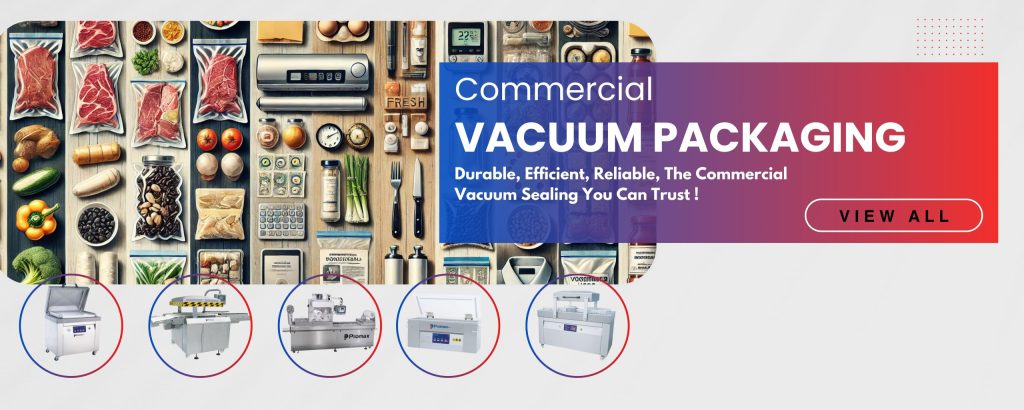Introduction
When it comes to preserving cheese and deli meats in grocery stores, restaurants, and even home kitchens, two common storage methods dominate the industry: vacuum-sealing and cling film (plastic wrap). But which method truly keeps products fresher for longer?
This article explores the advantages and drawbacks of both storage techniques, using real-world comparisons, facts, and figures to help grocery store owners, food processors, and consumers make the best choice.
Understanding the Two Storage Methods
Vacuum-Sealing
Vacuum-sealing removes air from the packaging, creating an airtight environment that significantly slows bacterial growth, oxidation, and moisture loss. This method is widely used in commercial food storage due to its ability to preserve freshness for extended periods.
Cling Film (Plastic Wrap)
Cling film is a thin plastic sheet that wraps around food items, creating a barrier against external contaminants while maintaining some breathability. While it offers a quick and inexpensive way to cover food, it does not prevent air exposure, leading to faster spoilage.
Comparison: Freshness, Shelf Life & Cost Efficiency
1. Shelf Life: How Long Does Food Stay Fresh?
| Food Item | Cling Film Shelf Life | Vacuum-Sealed Shelf Life |
|---|---|---|
| Sliced Deli Meat | 3-5 days | 2-3 weeks |
| Whole Deli Meat | 5-7 days | 3-4 weeks |
| Soft Cheese | 5-7 days | 2-3 weeks |
| Hard Cheese | 2-3 weeks | 4-6 months |
Key Takeaway: Vacuum-sealing significantly extends the shelf life of both cheese and deli meats, making it a superior option for long-term storage and reducing daily food waste.
2. Freshness & Quality Retention
- Cling Film: Allows some airflow, which leads to oxidation, moisture loss, and potential bacterial growth. Cheese may dry out and form a hard outer layer, while deli meats can develop a slimy texture due to bacterial activity.
- Vacuum-Sealing: Prevents oxidation and dehydration, keeping cheese creamy and fresh while ensuring deli meats retain moisture and texture.
💡 Real-World Insight: According to the USDA, vacuum-sealed meats stay fresher 3 to 5 times longer than those stored in plastic wrap.
3. Cost-Effectiveness: Initial Investment vs. Long-Term Savings
- Cling Film: Low initial cost, but leads to higher food waste due to faster spoilage.
- Vacuum-Sealing: Higher upfront cost for equipment but leads to long-term savings by reducing spoilage and food waste.
💰 Fact: Grocery stores using vacuum-sealing report 20-40% less product waste, directly improving profitability.
4. Environmental Impact
- Cling Film: Single-use plastic that contributes to environmental waste.
- Vacuum-Sealing: Uses plastic bags, but they can often be reused or recycled depending on the material.
♻️ Sustainability Tip: Some vacuum-sealing bags are now compostable or biodegradable, making them a more eco-friendly choice.
Pros and Cons of Each Storage Method
✅ Vacuum-Sealing Pros:
✔️ Extends shelf life by up to 5 times ✔️ Maintains flavor, texture, and moisture ✔️ Prevents freezer burn (for frozen storage) ✔️ Reduces grocery store waste ✔️ Improves food safety by limiting bacterial growth
❌ Vacuum-Sealing Cons:
❌ Requires an upfront investment in a vacuum sealer ❌ Uses more packaging material than cling film
✅ Cling Film Pros:
✔️ Readily available and inexpensive ✔️ Quick and easy to use ✔️ Works well for short-term storage
❌ Cling Film Cons:
❌ Limited protection against air and bacteria ❌ Leads to faster spoilage of food ❌ Generates more plastic waste
Final Verdict: Which is the Best Choice?
For short-term use (1-3 days), cling film can be a convenient and cost-effective option. However, for long-term storage, reducing waste, and maintaining product quality, vacuum-sealing is the superior choice.
For grocery stores, delis, and food service businesses, vacuum-sealing is a worthwhile investment that boosts freshness, cuts costs, and enhances customer satisfaction.

